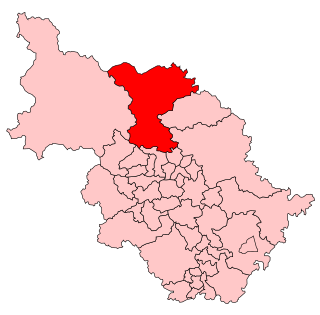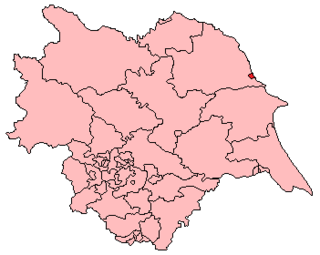Newport was a parliamentary borough located in Newport, which was abolished in for the 1885 general election. It was occasionally referred to by the alternative name of Medina.
The parliamentary borough of Finsbury was a constituency of the House of Commons of the UK Parliament from 1832 to 1885, and from 1918 to 1950. The constituency was first created in 1832 as one of seven two-seat "metropolis" parliamentary boroughs other than the two which already existed: Westminster and the City of London; the latter until 1885 retained an exceptional four seats. Finsbury was directly north of the City of London and was smaller than the Finsbury division of the Ossulstone hundred but took in land of Holborn division to its southwest in pre-introduction changes by Boundary Commissioners. It included Finsbury, Holborn, Moorfields, Clerkenwell, Islington, Stoke Newington and historic St Pancras. The 1918 constituency corresponded to the smaller Metropolitan Borough of Finsbury ; it was a seat, thus electing a single member, fulfilling a longstanding aim of Chartism which underscored the 1832 reforms.

North Derbyshire was a Parliamentary constituency in the United Kingdom constituencies. It originally returned two Knights of the Shire to the House of Commons of the Parliament of the United Kingdom.

Ripon was a constituency sending members to the House of Commons of England, Great Britain and the House of Commons of the Parliament of the United Kingdom until 1983, centred on the city of Ripon in North Yorkshire.

Clitheroe was a parliamentary constituency in Lancashire.

Scarborough was the name of a constituency in Yorkshire, electing Members of Parliament to the House of Commons, at two periods. From 1295 until 1918 it was a parliamentary borough consisting only of the town of Scarborough, electing two MPs until 1885 and one from 1885 until 1918. In 1974 the name was revived for a county constituency, covering a much wider area; this constituency was abolished in 1997.
Malton, also called New Malton, was a constituency of the House of Commons of the Parliament of England in 1295 and 1298, and again from 1640, then of the Parliament of Great Britain from 1707 to 1800 and of the Parliament of the United Kingdom from 1801 to 1885. It was represented by two Members of Parliament until 1868, among them the political philosopher Edmund Burke, and by one member from 1868 to 1885.

West Riding of Yorkshire was a parliamentary constituency in England from 1832 to 1865. It returned two Members of Parliament (MPs) to the House of Commons of the Parliament of the United Kingdom.

Leeds was a parliamentary borough covering the town of Leeds, in the West Riding of Yorkshire, England. It was represented in the House of Commons of the Parliament of the United Kingdom from 1832 to 1885.

East Riding of Yorkshire was a parliamentary constituency covering the East Riding of Yorkshire, omitting Beverley residents save a small minority of Beverley residents who also qualified on property grounds to vote in the county seat. It returned two Members of Parliament to the House of Commons of the Parliament. A brief earlier guise of the seat covered the changed franchise of the First Protectorate Parliament and Second Protectorate Parliament during a fraction of the twenty years of England and Wales as a republic.
North Northamptonshire was a county constituency in Northamptonshire, represented in the House of Commons of the Parliament of the United Kingdom.
Thirsk was a parliamentary borough in Yorkshire, represented in the English and later British House of Commons in 1295, and again from 1547. It was represented by two Members of Parliament until 1832, and by one member from 1832 to 1885, when the constituency was abolished and absorbed into the new Thirsk and Malton division of the North Riding of Yorkshire.
Northallerton was a parliamentary borough in the North Riding of Yorkshire, represented by two Members of Parliament in the House of Commons briefly in the 13th century and again from 1640 to 1832, and by one member from 1832 until 1885.
Knaresborough was a parliamentary constituency which returned two Members of Parliament (MPs) to the Parliament of England, Parliament of Great Britain and the House of Commons of the Parliament of the United Kingdom until 1868, and then one MP until its abolition in 1885.

East Cornwall was a county constituency in the House of Commons of the Parliament of the United Kingdom. It elected two Members of Parliament (MPs) by the bloc vote system of election.
Kingston upon Hull, often simply referred to as Hull, was a parliamentary constituency in Yorkshire, electing two members of parliament to the Parliaments of England, Great Britain and House of Commons of the Parliament of the United Kingdom, from 1305 until 1885. Its MPs included the anti-slavery campaigner, William Wilberforce, and the poet Andrew Marvell.

East Kent was a county constituency in Kent in South East England. It returned two Members of Parliament (MPs) to the House of Commons of the Parliament of the United Kingdom, elected by the first past the post system.
South Wiltshire, formally known as the Southern division of Wiltshire or Wiltshire Southern was a county constituency in the county of Wiltshire in South West England. It returned two Members of Parliament to the House of Commons of the Parliament of the United Kingdom, elected by the bloc vote system.
East Worcestershire was a county constituency in the county of Worcestershire, represented in the House of Commons of the Parliament of the United Kingdom.

William Reginald Duncombe, Viscount Helmsley, was a British Conservative Party politician.








